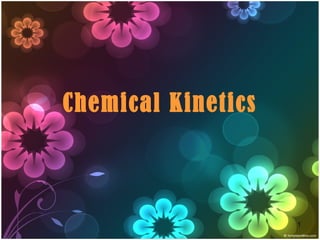This document discusses the topic of chemical kinetics, which deals with the rates and mechanisms of chemical reactions. It provides definitions for key concepts such as reaction rate, factors that affect reaction rates like concentration and temperature, and order of reactions. Catalysts are also explained as substances that speed up reactions without being consumed. The document then covers chemical equilibrium, including definitions of the equilibrium constant, Le Chatelier's principle, and the relationship between the equilibrium constant and Gibbs free energy.








![Homogeneous reactions are chemical reactions in
which the reactants are in the same phase.
2CO(g) + O2(g) 2CO2 (g) R1 =k1 [CO]2
[O2]
R2 =k2 [CO2]2](https://image.slidesharecdn.com/2kineticsequilibrium-151203094032-lva1-app6891/85/2-kinetics-amp-equilibrium-9-320.jpg)
![Heterogeneous reactions have reactants in two or more
phases. Reactions that take place on the surface of a catalyst
of a different phase are also heterogeneous.
! Solid state is not on account
S(s) + O2 (g) SO2 (g) R1 =k1[O2]
R2 =k2[SO2]](https://image.slidesharecdn.com/2kineticsequilibrium-151203094032-lva1-app6891/85/2-kinetics-amp-equilibrium-10-320.jpg)




























































